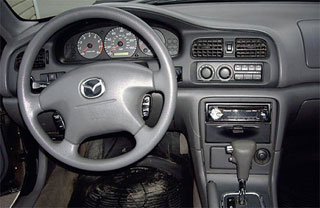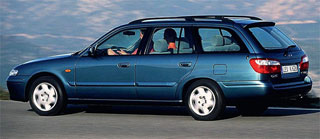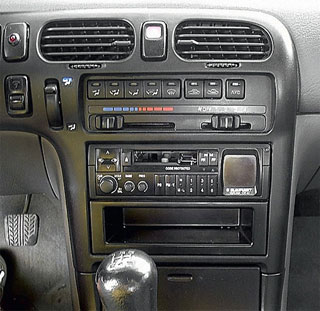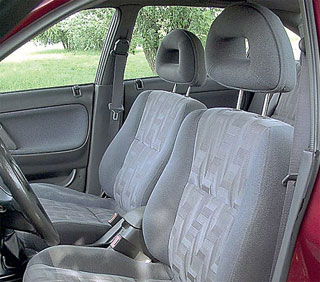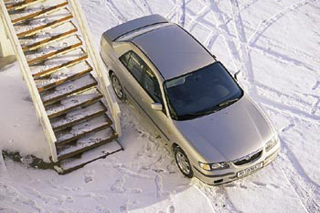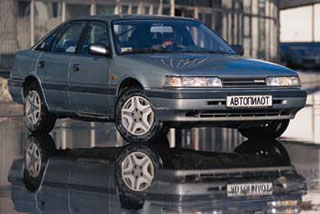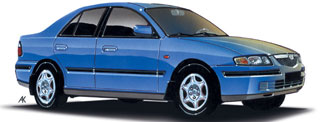Test drive Mazda 626 MK5 Sedan 1997 - 2002 Sedan
Relax…
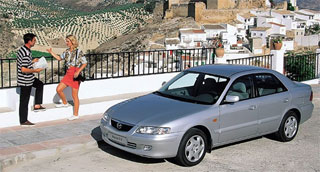 Some motorists see only wheels in the car. They do not want the vehicle to reflect their character or impose their own, do not want to strain on the trip, constantly face the shortcomings of the iron horse.
Some motorists see only wheels in the car. They do not want the vehicle to reflect their character or impose their own, do not want to strain on the trip, constantly face the shortcomings of the iron horse. Surprisingly, in the lineup of the company Mazda (now known by rather energetic cars forcing drivers to be in good shape), simple cars were once present, which were a means of transportation and nothing more. Take at least the predecessor of the famous six with index 626: since time immemorial, the family Mazda was a kind of Camry's shadow without much nature and any bright features. Today we’ll talk about the model of the last generation GF, which has become the top of the development of this version of the brand. Looking ahead, we will delight potential buyers: the machine does not bother the owner not only in everyday life, but also when calculating the operating costs. The reliability of the car, of course, is not phenomenal, but quite sufficient for the owner to go far, far, far away without excitement.
A balanced, calm, almost no emotion, the appearance of 626 GF is hardly out of the rut of a person who is looking for only transport (aesthetes this moment will surely embarrass, forcing him to refuse to buy). Both the sedan and the station wagon look less expressive than even the 626 GE of the previous generation, although it is also that was still remembered. At the same time, the six are noticeably slimmer than the predecessor, and the headlights shine better than before. In addition, there was no version of the station wagon in the body of an old -style car. There are no complaints about corrosion resistance and reliability of electricians. It is pleasant that to change the fuel filter of rough cleaning, it is enough to remove the hatch in the cabin, unlike GE, which had to remove the gas tank is not easy and expensive.
If the 626 GE was both a chubby fat man, then the last generation model in all angles was significantly pulled up: the salon looks more strict, tough, clear, collected and therefore seems more sympathetic than the interior of the predecessor. By the way, in this generation, Mazda divided the 626th model (not otherwise looking at Honda) on the versions for Europe and the States. This is probably why GF is poorer equipped than GE (after all, a European motorist
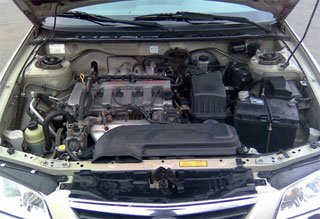 calculation). In particular, a leather salon for 626 GF is not provided. Especially if we are talking about a right -handed version of Capella (in Japan they don’t like leather upholstery at all; I remember that the 1998 Cadillac STS is specially released with a fabric salon for this country, despite the STS without a leather salon on sale). However, although the GF equipment is more modest than that of the previous generation car, there are no complaints about ergonomics and the quality of the finish, and practicality is at a high level (the interior is spacious, moreover, the possibilities of its transformation are wide enough).
calculation). In particular, a leather salon for 626 GF is not provided. Especially if we are talking about a right -handed version of Capella (in Japan they don’t like leather upholstery at all; I remember that the 1998 Cadillac STS is specially released with a fabric salon for this country, despite the STS without a leather salon on sale). However, although the GF equipment is more modest than that of the previous generation car, there are no complaints about ergonomics and the quality of the finish, and practicality is at a high level (the interior is spacious, moreover, the possibilities of its transformation are wide enough). Wast qualities can be characterized as average: handling is quite decent, but the smoothness of the course leaves much to be desired, in fact, GE was exactly the same, and GF was built on an old platform without significant changes in the chassis. The dynamics of acceleration of the usual even Honda Accord of those years had a version of Type R with the H22 engine (from the Prelude model), and here the maximum that was proposed, the 136-horsepower inherent four with a volume of 2 liters (by the way, it did not have the previous modification).
For the most part, motors are the same as that of Mazda 626 GE: two 100-horsepower (2-liter diesel and 1.8-liter gasoline), two gasoline 2-liter (115-horsepower and 136-horsepower). The European GF does not have six-cylinder power units (except that the version for the states still has a 2.5-liter V6). The characteristics of the engines are in principle similar, although the Japanese still made some changes to the design: in particular, they got rid of the hydraulic compensators in favor of the goals (as a result, the engines became a little noisy), refused the ignition system with the trambler, installing more modern high-voltage coils instead of them . The innovations practically did not affect reliability: the nozzles of the fuel injection system are still immune to pollution, a torn timing belt does not entail a meeting of pistons with valves. In general, in order to maintain the engine in good condition, it is enough to change oil with filters on time (approximately every 10 thousand km), however, the 626th motors love quality oil and do not favor cheap lubricant. This is not to say that the units are absolutely reliable: due to the clogged mesh in the gas tank, the craving in the bend may still abuse, and the Carter pallet of some cars sweat.
The automatic and mechanical gearboxes installed on the Mazda 626 GF are very reliable, and only those owners who deliberately bring the boxes to complete wear and tear problems. If unnecessary troubles are not needed and I want to ride for a long time without additional expenses, then it makes sense after 3040 thousand km to change the oil in the machine. Clutch in the manual transmission requires replacement, as a rule, every 120 thousand km.
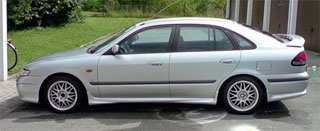 The suspension is almost the same as that of 626 GE, and therefore, the problems are about the same primarily torn antioxer anthers, short -lived steering rods. The front blocks of the front levers are not reliable and the silent blocks of the front levers (and it will not work to take and impress new ones, you will have to change the details in the collection). More often than I would like, you have to change the racks of reptile stability stabilizers. In this regard, right -handed Capella in operation will cost cheaper, since the rear stabilizer is rare for it, and since there is no detail, there is no cost of expenses. In often there are also disc rear brakes, for some reason the Japanese in the vast majority of cases installed drums on Capella. I must say that the change of generation nevertheless marked separate pleasant constructive changes, for example, GE had a lot of complaints for calipers, and in 626 GF such problems arise much less often. It would seem that a trifle, but repairs of calipers are painstaking, difficult, capable of taking away several hours (especially from an inept fan to do everything yourself).
The suspension is almost the same as that of 626 GE, and therefore, the problems are about the same primarily torn antioxer anthers, short -lived steering rods. The front blocks of the front levers are not reliable and the silent blocks of the front levers (and it will not work to take and impress new ones, you will have to change the details in the collection). More often than I would like, you have to change the racks of reptile stability stabilizers. In this regard, right -handed Capella in operation will cost cheaper, since the rear stabilizer is rare for it, and since there is no detail, there is no cost of expenses. In often there are also disc rear brakes, for some reason the Japanese in the vast majority of cases installed drums on Capella. I must say that the change of generation nevertheless marked separate pleasant constructive changes, for example, GE had a lot of complaints for calipers, and in 626 GF such problems arise much less often. It would seem that a trifle, but repairs of calipers are painstaking, difficult, capable of taking away several hours (especially from an inept fan to do everything yourself). In general, 626 GF is a worthy choice. This is a solid, reliable, comfortable, practical and simple car, which, despite the boring in general, gives the impression of a lady car. Great transport! However, it is prevented from recommending it to readers that in the secondary market it comes across infrequently, therefore, it is not easy to purchase original spare parts, and many details will have to be ordered. However, there is enough quality non -original in stores. So there are simply no serious contraindications for buying this model.
The advantages and disadvantages of the model
Advantages
High reliability, powerful headlights, thought out interior
Flaws
Deficiency of original spare parts, solid age of the model, insufficiently powerful motors
Approximate price order for the 626th model in Moscow, rub.:
80 000 (1997 onwards, with a motor 1.8 l);
190 000 (1997 onwards, with a 2 l engine);
230,000 (2000 onwards, with a 2 l engine and automatic transmission);
250 000 (2002 onwards, with a motor 1.8 l);
280 000 (2002 onwards, with a 2 l and automatic transmission engine);
320,000 (American 2001 onwards, with V6 2.5 l).
